The bond market was volatile last month. Initially, concerns over high tech valuations led to price gains, but inflation worries later returned to the fore. Overall, the bond markets fell only slightly month-on-month.
You are here:
Market overview: Volatile financial markets
The financial markets were once again volatile last month. Initially, concerns about high technology valuations weighed on the markets, but the environment improved following the end of the government shutdown and hopes for further monetary easing in the USA. As a result, equities and bonds have trended sideways month-on-month.
Indexed performance of government bonds in local currency
100 = 01.01.2025
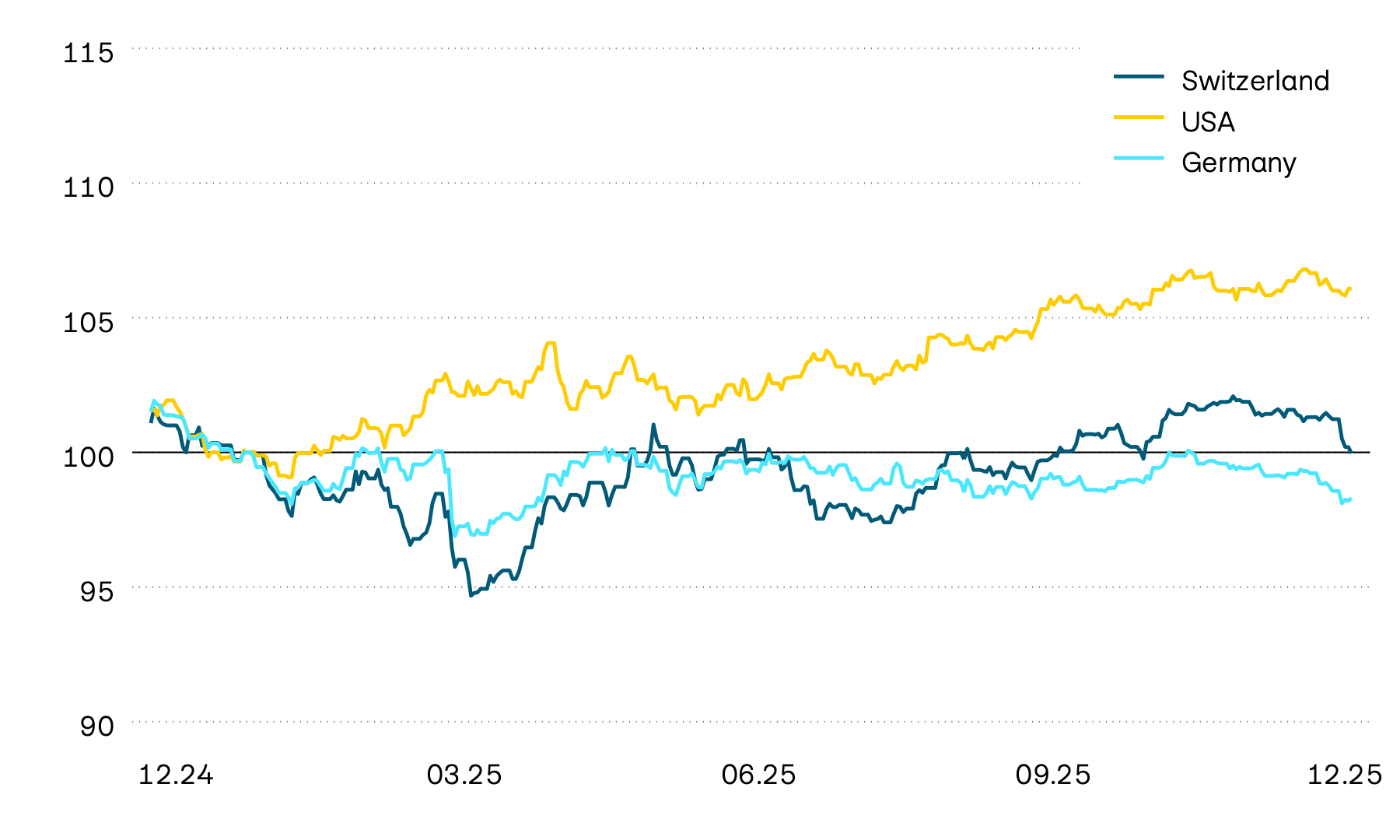
Performance on the bond markets remained volatile last month. The value of government bonds initially rose sharply in the second half of November. This was probably triggered by concerns on the equity market about the potentially excessive valuations of tech stocks. The subsequent reversal is likely to have been caused by renewed concerns over inflation and the resulting uncertainty over future monetary policy in the USA and Europe. Current worries about inflation are not unfounded, as core inflation remains above the 2 percent target in both the USA and Europe. In December, however, the US Federal Reserve cut policy rates by a further 25 basis points, which reduced losses slightly, at least on the US bond markets.
Trend in 10-year yields to maturity
In percent
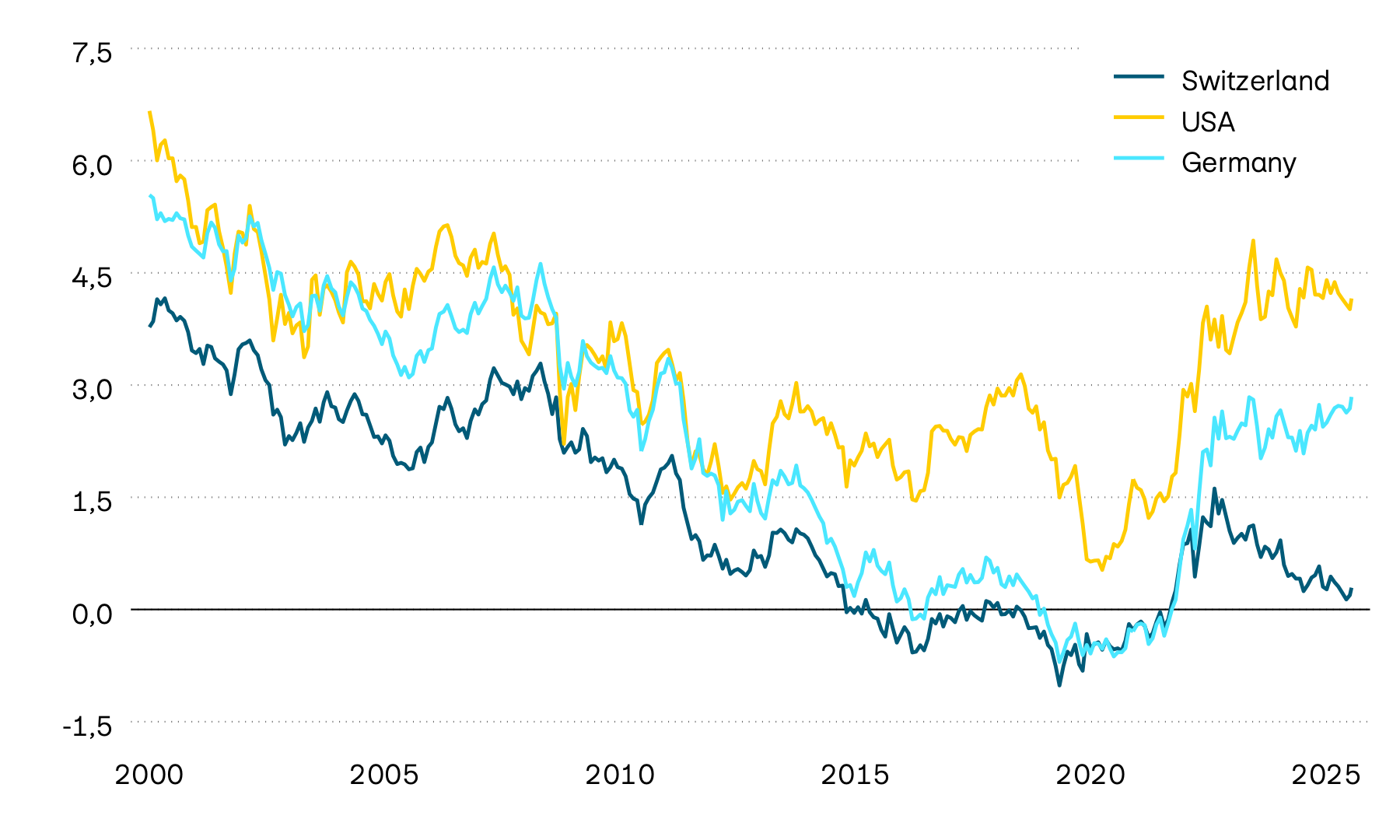
Due to renewed concerns over inflation, yields to maturity on 10-year government bonds rose significantly at the end of November. In Germany, 10-year yields to maturity are just under 3 percent, only slightly below their five-year high. Yields to maturity also climbed particularly sharply in Japan. They now stand at almost 2 percent, an increase of almost 100 basis points year-on-year. Statements by the Governor of the Bank of Japan (BoJ), Kazuo Ueda, signalling an increase in policy rates, are likely to have contributed to this rise. Given the continued high core inflation rate of 3 percent, such a move would not be unfounded. In Switzerland, yields to maturity also climbed recently and now stand at 0.25 percent. The Swiss National Bank’s (SNB) recent decision to leave the policy rate at 0 percent has done little to change this.
Credit spreads on corporate bonds
In percentage points
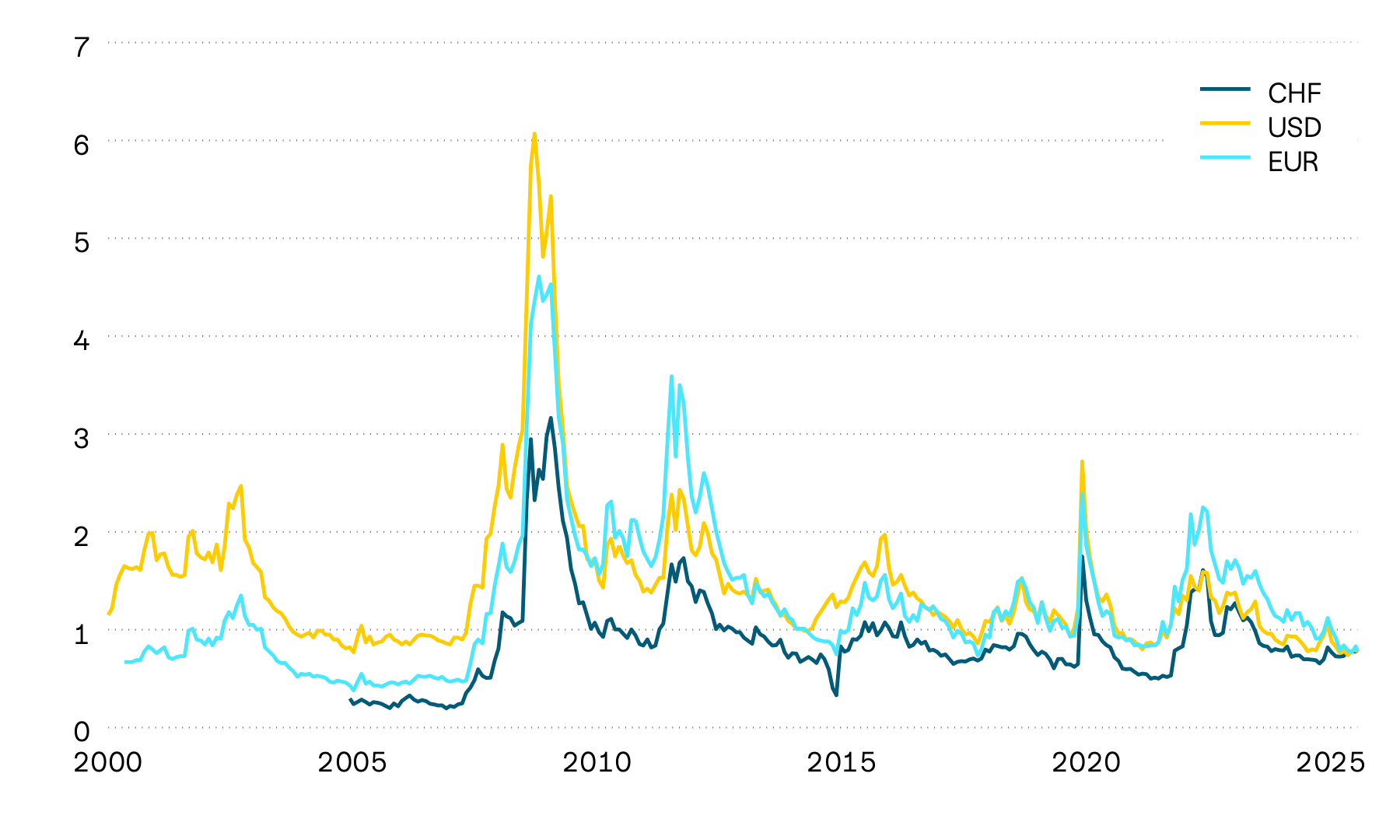
In light of renewed concerns about the valuations of tech stocks and the resulting subdued mood on the financial markets, credit spreads on corporate bonds widened temporarily, albeit from a low starting level. However, this was not sustainable. As optimism returned to the equity markets, credit spreads narrowed significantly again, meaning that the corporate bond market still shows no sign of recession fears.
Like the bond market, the equity markets experienced ups and downs. Concerns over the high valuations of tech companies initially weighed on prices. However, optimism returned towards the end of the month.
Indexed stock market performance in Swiss francs
100 = 01.01.2025
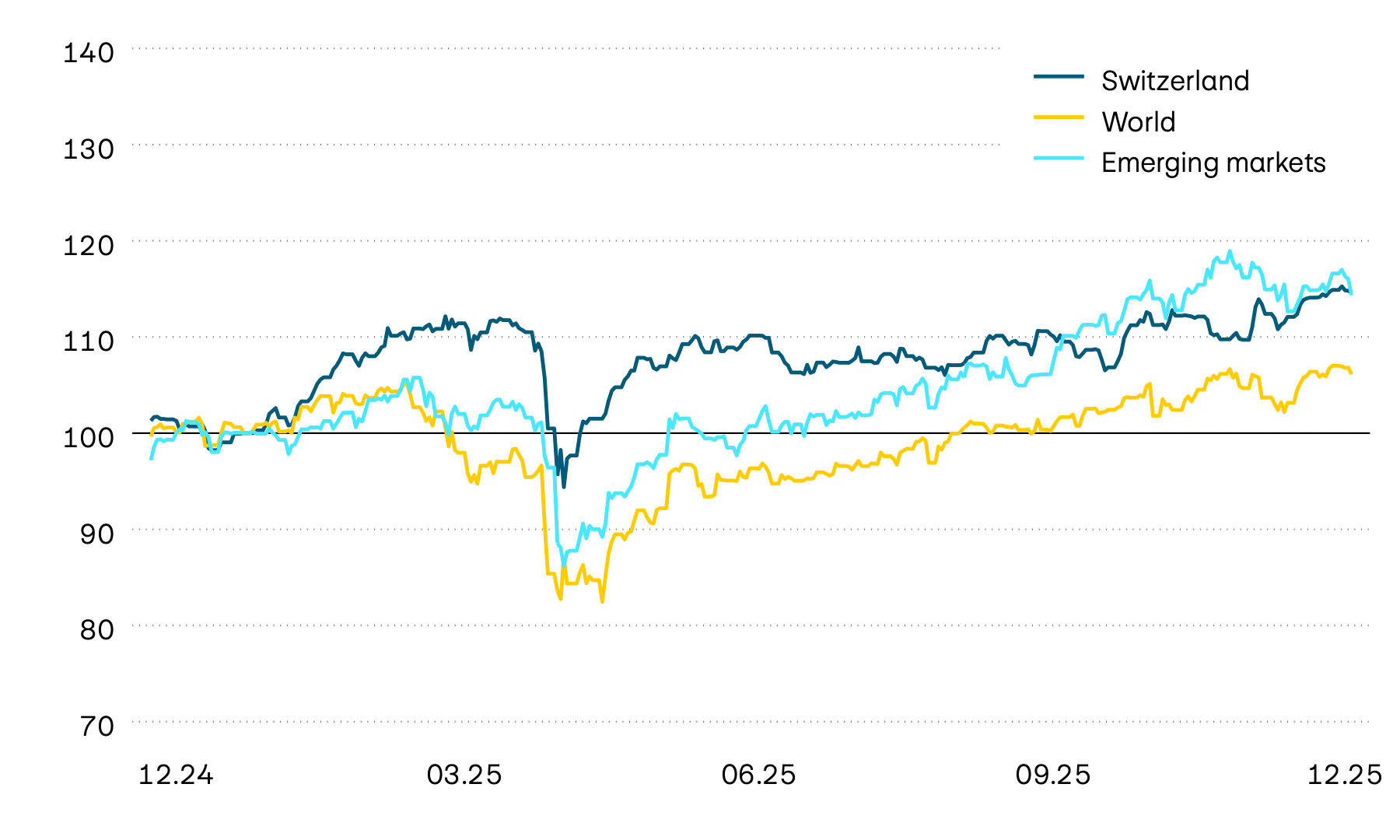
Similar to the bond markets, the equity markets also experienced a turbulent month. Initially, global optimism was dampened by concerns over the high valuations of tech stocks in particular. Investors increasingly questioned whether the large-scale investments in artificial intelligence would actually pay off as expected. As a result, the equity markets fell noticeably in the second half of November. However, optimism returned towards the end of the month. This was likely due in part to the end of the US government shutdown and to renewed hopes that the US Federal Reserve would take further monetary policy easing measures in December. However, the associated economic concerns are currently being largely ignored by the financial markets.
Momentum of individual markets
In percent
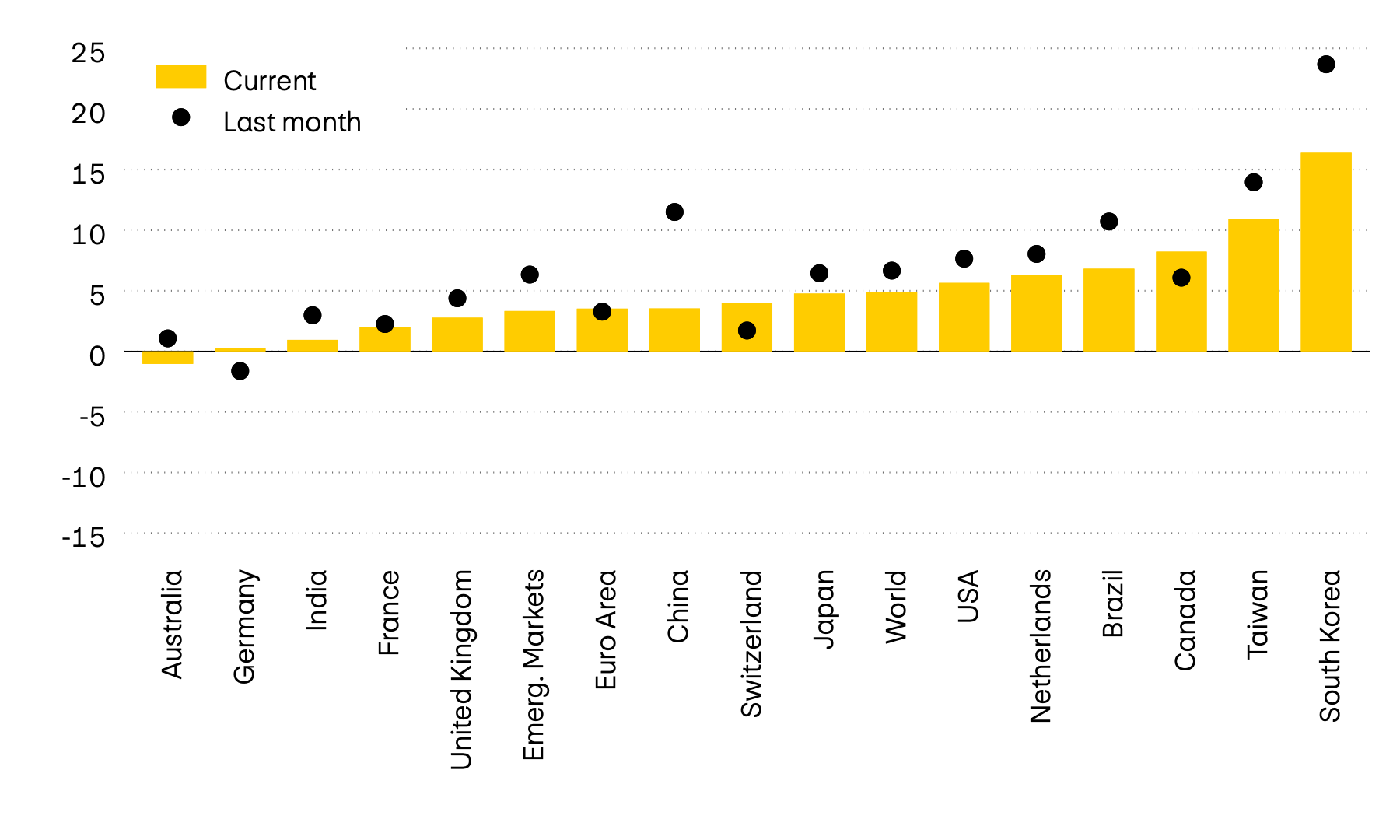
With the temporary dampening of optimism on the equity markets, particularly in tech stocks, momentum also slowed in many countries. The decline was most pronounced in tech-heavy markets such as South Korea and Taiwan. By contrast, momentum on the Swiss equity market continued to gain ground. After failing to recover significantly from the slump since April, it caught up considerably last month. Index heavyweight Roche made a significant contribution to this. The pharmaceutical group’s share price rose sharply following positive study results and news of success for several drugs, climbing by around 18 percent month-on-month.
Price/earnings ratio
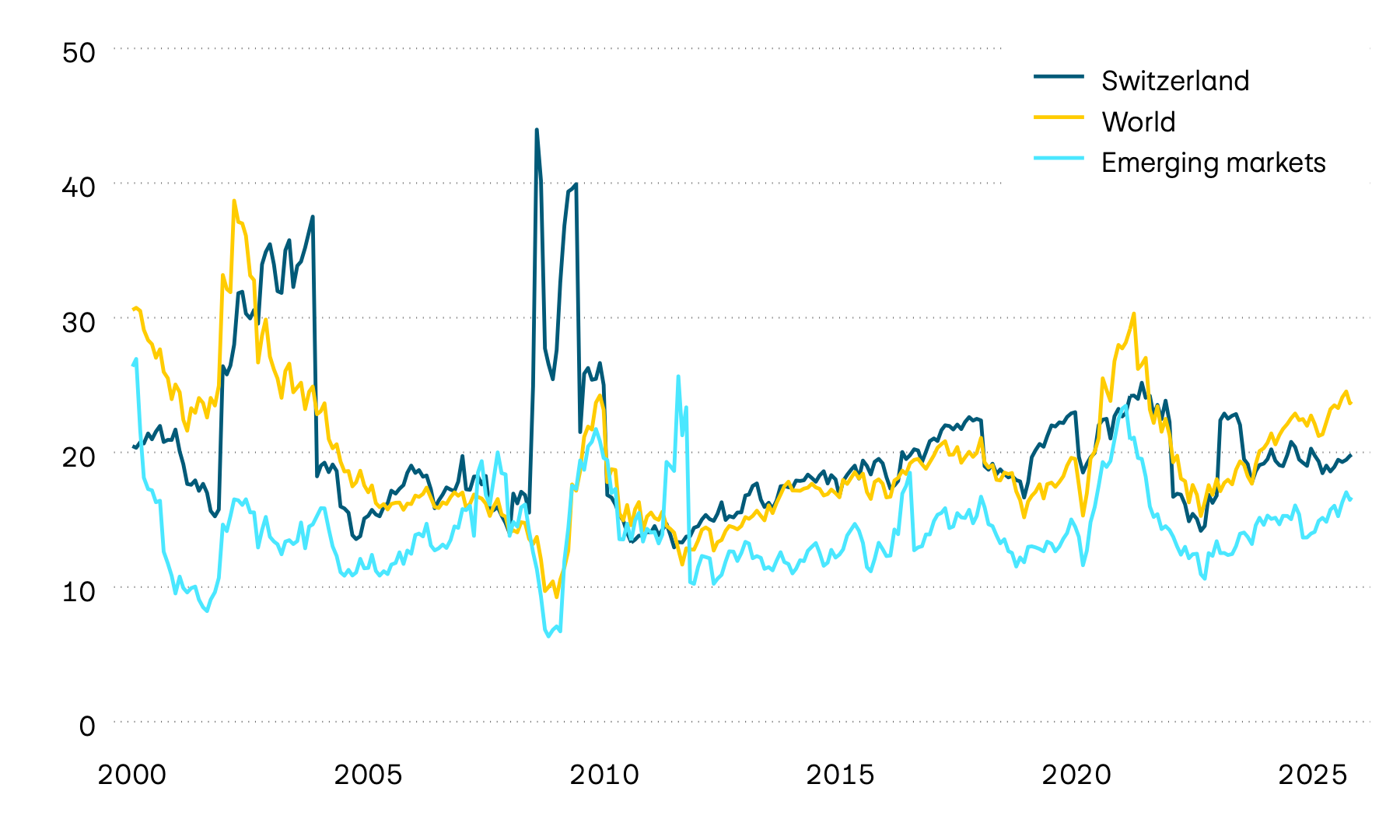
The downturn on the equity market and subsequent recovery meant that equity prices remained virtually changed month-on-month. Combined with the particularly strong reporting season for companies in the technology sector, this is likely to have reduced the price/earnings ratio (P/E ratio) of the tech-heavy equity market in the USA and emerging markets. In contrast, the P/E ratio rose in Switzerland, probably due in large part to the strong performance of the Swiss equity market last month.
Exchange-listed Swiss real estate funds made slight gains again last month and are likely to generate a substantial return at the end of the year.
Indexed performance of Swiss real estate funds
100 = 01.01.2025

The performance of exchange-listed Swiss real estate funds so far this year can be divided into three phases: in the first phase, which lasted around four months, prices trended sideways and confirmed existing patterns. This was followed in May by a second phase featuring a sharp jump in prices, which then consolidated and held their ground until around August. Since then, we have entered a third phase with a slight upward trend. Overall, the value of Swiss real estate funds has risen by around 8 percent over the course of 2025 so far. This development was primarily due to the continuous decline in long-term Swiss capital market interest rates.
Premium on Swiss real estate funds and 10-year yields to maturity
In percent

The premium paid on investments in exchange-listed real estate funds compared to the net asset value of the underlying properties (known as the premium) rose again slightly last month due to the increase in value on the stock exchange. A comparison over the past 20 years shows that premiums usually rise when capital market interest rates fall, and that they tend to fall when capital market interest rates rise. It is also clear that the current level is extraordinarily high and has only been reached over the past two decades during the period of negative capital market interest rates before the pandemic.
3-month SARON and 10-year yields to maturity
In percent

In Switzerland, inflation fell again slightly last month and currently stands at 0 percent. As expected by market participants, the Swiss National Bank decided to leave policy rates at 0 percent, emphasizing the high hurdle for negative interest rates. Yields to maturity on 10-year Swiss government bonds rose by around 10 basis points in early December and now stand at 0.25 percent.
Currencies
Measured in Swiss francs, gold remains close to its all-time high. The euro made up ground against the Swiss franc.
| Currency pair | Price | PPP | Neutral range | Valuation |
|---|---|---|---|---|
| Currency pair EUR/CHF |
Price 0.94 |
PPP 0.92 |
Neutral range 0.85 – 0.99 |
Valuation Euro neutral |
| Currency pair USD/CHF |
Price 0.80 |
PPP 0.79 |
Neutral range 0.69 – 0.89 |
Valuation USD neutral |
| Currency pair GBP/CHF |
Price 1.07 |
PPP 1.13 |
Neutral range 0.98 – 1.28 |
Valuation Pound sterling neutral |
| Currency pair JPY/CHF |
Price 0.51 |
PPP 0.84 |
Neutral range 0.68 – 1.00 |
Valuation Yen undervalued |
| Currency pair SEK/CHF |
Price 8.63 |
PPP 9.88 |
Neutral range 8.83 – 10.92 |
Valuation Krona undervalued |
| Currency pair NOK/CHF |
Price 7.93 |
PPP 10.43 |
Neutral range 9.17 – 11.70 |
Valuation Krone undervalued |
| Currency pair EUR/USD |
Price 1.17 |
PPP 1.17 |
Neutral range 1.02 – 1.32 |
Valuation Euro neutral |
| Currency pair USD/JPY |
Price 156.03 |
PPP 93.91 |
Neutral range 71.50 – 116.31 |
Valuation Yen undervalued |
| Currency pair USD/CNY |
Price 7.06 |
PPP 6.35 |
Neutral range 5.85 – 6.85 |
Valuation Renminbi undervalued |
Source: Allfunds Tech Solutions
There were no major changes in this year’s currency movements last month. Only the euro appreciated against the Swiss franc. After hitting an all-time low against the Swiss franc in mid-November, the euro subsequently recouped most of these losses and is currently trading almost unchanged against the Swiss franc on an annual basis. By contrast, the US dollar was unable to continue its appreciation between September and mid-November and fell in value on a trade-weighted basis.
Cryptocurrencies
| Cryptocurrency | Price | YTD in USD | Annual high | Annual low |
|---|---|---|---|---|
| Cryptocurrency BITCOIN |
Price 92,036 |
YTD in USD –1.44% |
Annual high 124,728 |
Annual low 76,244 |
| Cryptocurrency ETHEREUM |
Price 3,328 |
YTD in USD –0.12% |
Annual high 4,836 |
Annual low 1,471 |
Source: Allfunds Tech Solutions, Coin Metrics Inc
Gold
The gold price measured in Swiss francs stabilized just below its record high last month and currently stands at 3,350 Swiss francs per troy ounce.
Indexed performance of gold in Swiss francs
100 = 01.01.2025

The gold price briefly slipped back in the second half of November. However, this didn’t last long, and the price stabilized at 4,200 US dollars per troy ounce in December. This is just below its all-time high of 4,400 US dollars. Measured in Swiss francs, the increase in value since the start of the year still stands at over 40 percent.
